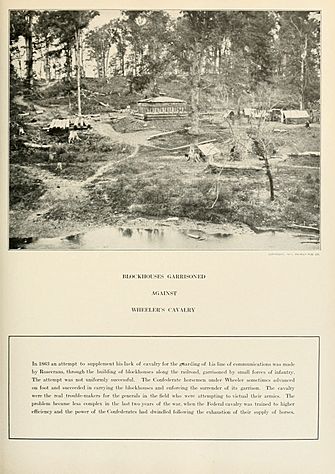Wheeler's October 1863 Raid facts for kids
Quick facts for kids Wheeler's October 1863 Raid |
|||||||
|---|---|---|---|---|---|---|---|
| Part of the American Civil War | |||||||
|
Blockhouses garrisoned against Wheeler's cavalry |
|||||||
|
|||||||
| Belligerents | |||||||
| Commanders and leaders | |||||||
| Robert Byington Mitchell George Crook |
Joseph Wheeler | ||||||
| Strength | |||||||
| Elements of 2 cavalry divisions | 2½ cavalry divisions | ||||||
| Casualties and losses | |||||||
| 533+ men, 1,000 mules, 500 wagons |
698+ men, 6 cannons |
||||||
Wheeler's October 1863 Raid was a big attack by horse soldiers (cavalry) during the American Civil War. It happened in southeastern Tennessee from October 1 to 9, 1863. Confederate General Joseph Wheeler's cavalry had a good start. But then, they faced tough fights from Union cavalry as they tried to leave the area.
Contents
Why the Raid Happened
After a battle called Battle of Chickamauga, the Union Army was stuck in the city of Chattanooga, Tennessee. Confederate General Braxton Bragg's army had surrounded them. The Union soldiers needed supplies, but it was hard to get them into the city.
Their main supply route was a long, 60-mile wagon path. It went over a place called Walden's Ridge. General Bragg wanted to stop these supplies. So, he ordered General Wheeler to take most of his cavalry and attack the Union supply lines.
Surprise Attack at Anderson's Cross Roads
On October 1, General Wheeler began his raid. He had several cavalry groups with him. They quickly broke through the Union defenses near Decatur, Tennessee. Then, they rode towards Walden's Ridge.
On October 2, at Anderson's Cross Roads, Wheeler's men found a huge supply train. It had 800 wagons pulled by mules. There were also wagons from sellers who followed the army. The few Union guards were easily defeated. Wheeler's soldiers started to destroy the wagons and kill the mules, as ordered.
However, many soldiers began to take new clothes and other items from the wagons. This looting lasted for about eight hours. It was hard for the officers to stop it.
Soon, Union cavalry arrived. Colonel Edward M. McCook led his soldiers into a fight. McCook's men lost 70 soldiers. But they managed to get back 800 mules and some wagons. They also caused 270 losses for the Confederates. Another Confederate group captured McMinnville, Tennessee, taking 388 Union soldiers as prisoners.
The Chase to Farmington
By October 7, Union General Robert Byington Mitchell gathered his cavalry forces. They were at Shelbyville, Tennessee. That day, Union General George Crook's men fought a Confederate group near Farmington. The Union lost 75 soldiers, but the Confederates lost 310.
The chase continued in bad weather. Some Union cavalry rode as far as 57 miles. General Wheeler finally escaped across the Tennessee River on October 9. This happened near Rogersville, Alabama. But before he got away, another 95 of his horsemen were captured near Pulaski, Tennessee.
What Happened After
General Wheeler did a lot of damage to the Union's supply line. The Union estimated he destroyed 500 wagons. Wheeler himself claimed his men killed 1,000 mules.
However, during the chase, Wheeler's cavalry was badly beaten by the Union horsemen. His command was almost completely ruined. Because of the strong Union cavalry, another planned Confederate raid was canceled.



